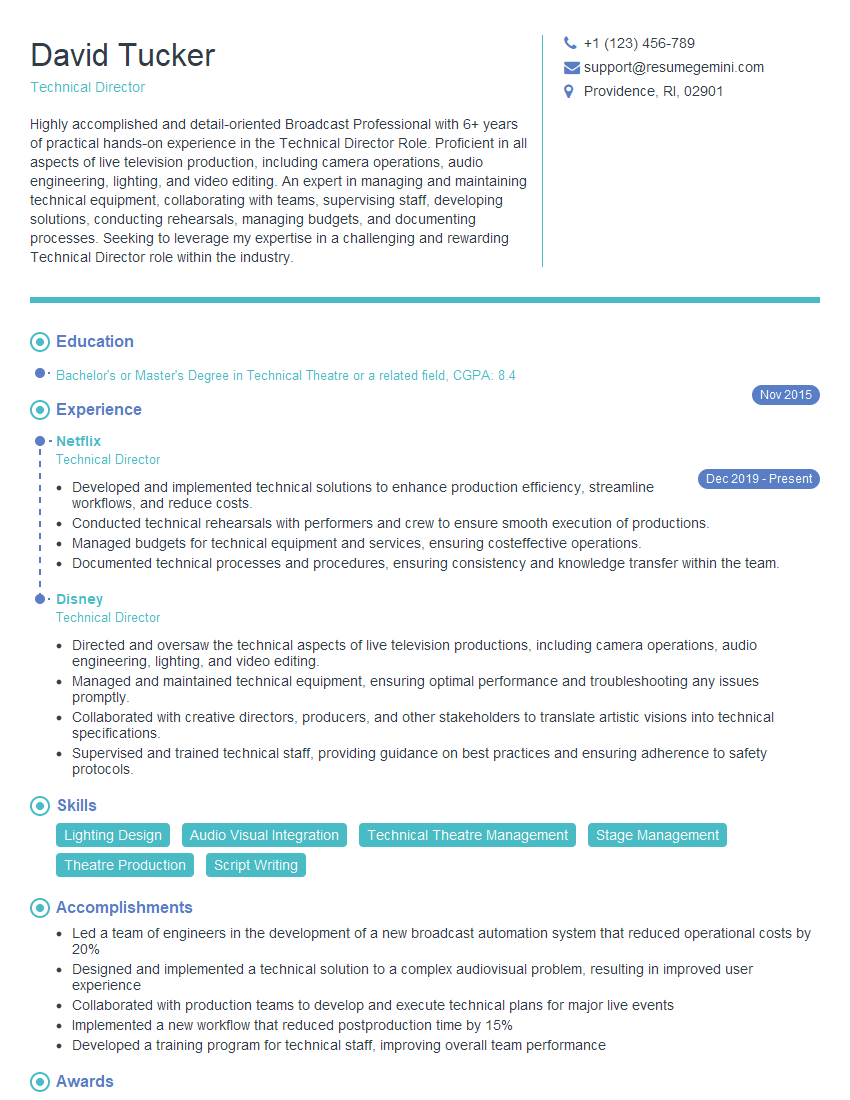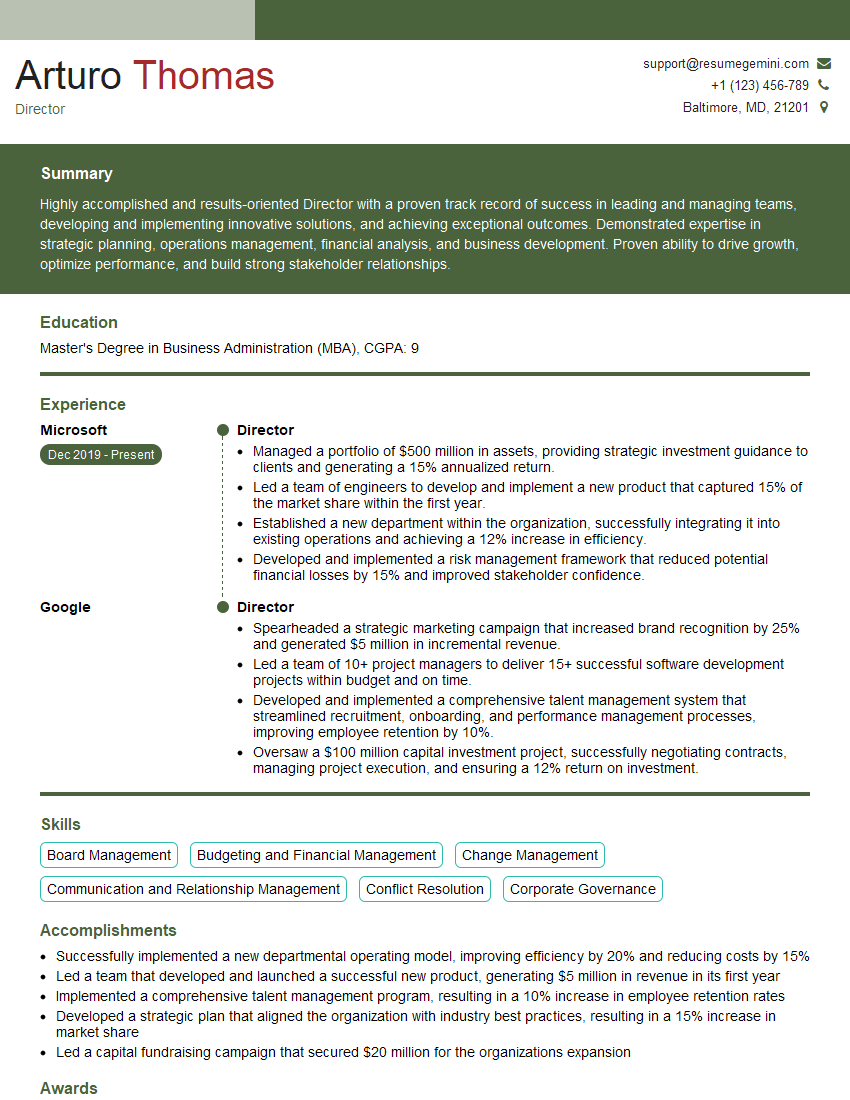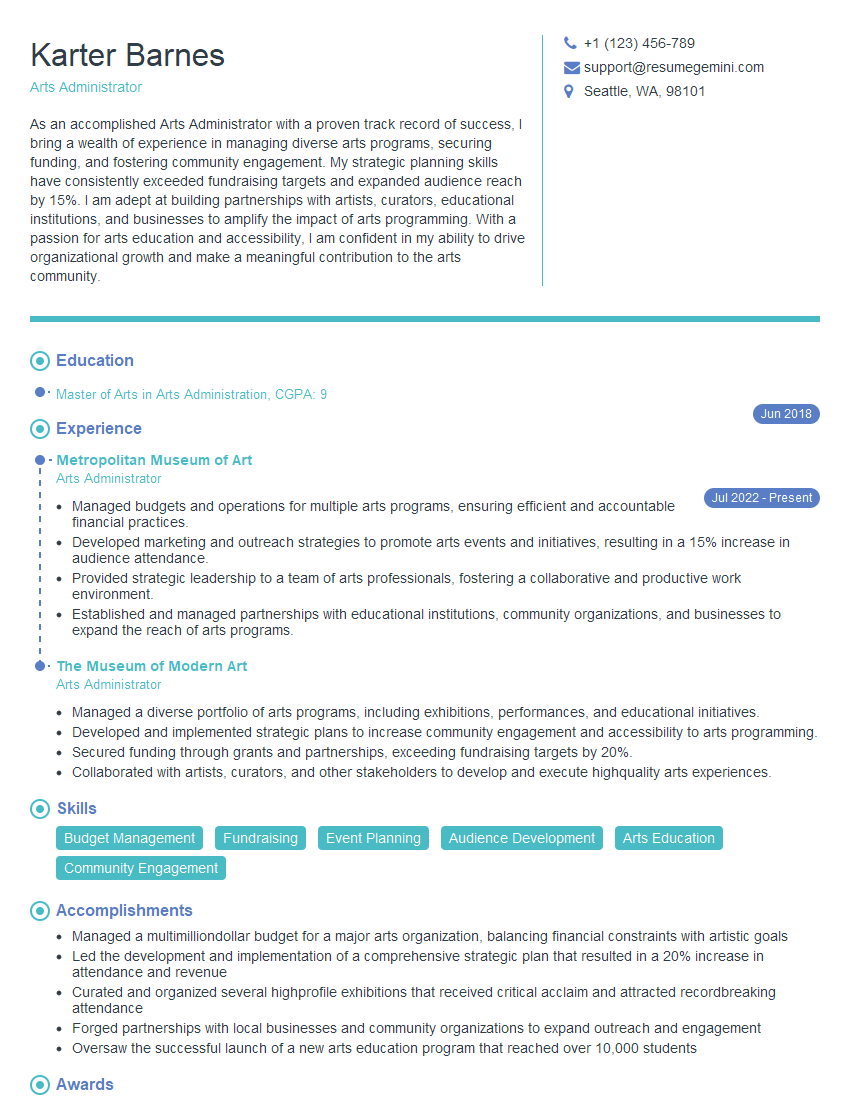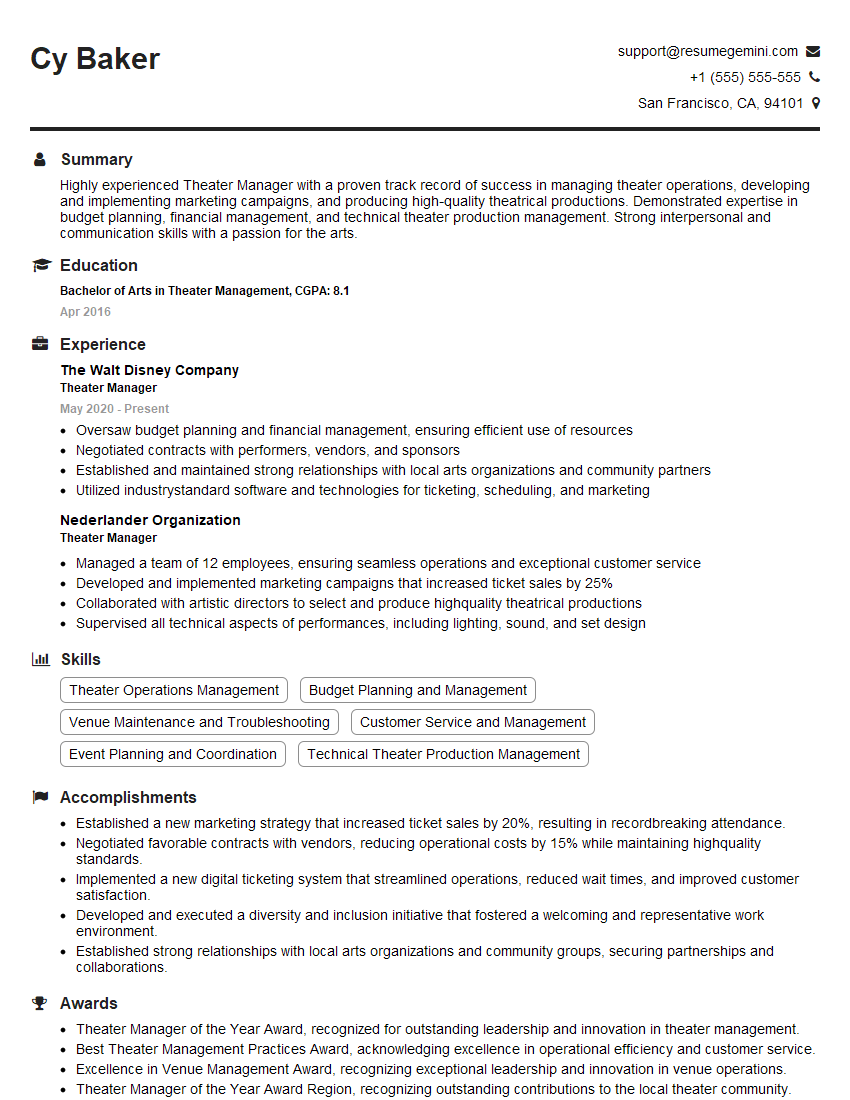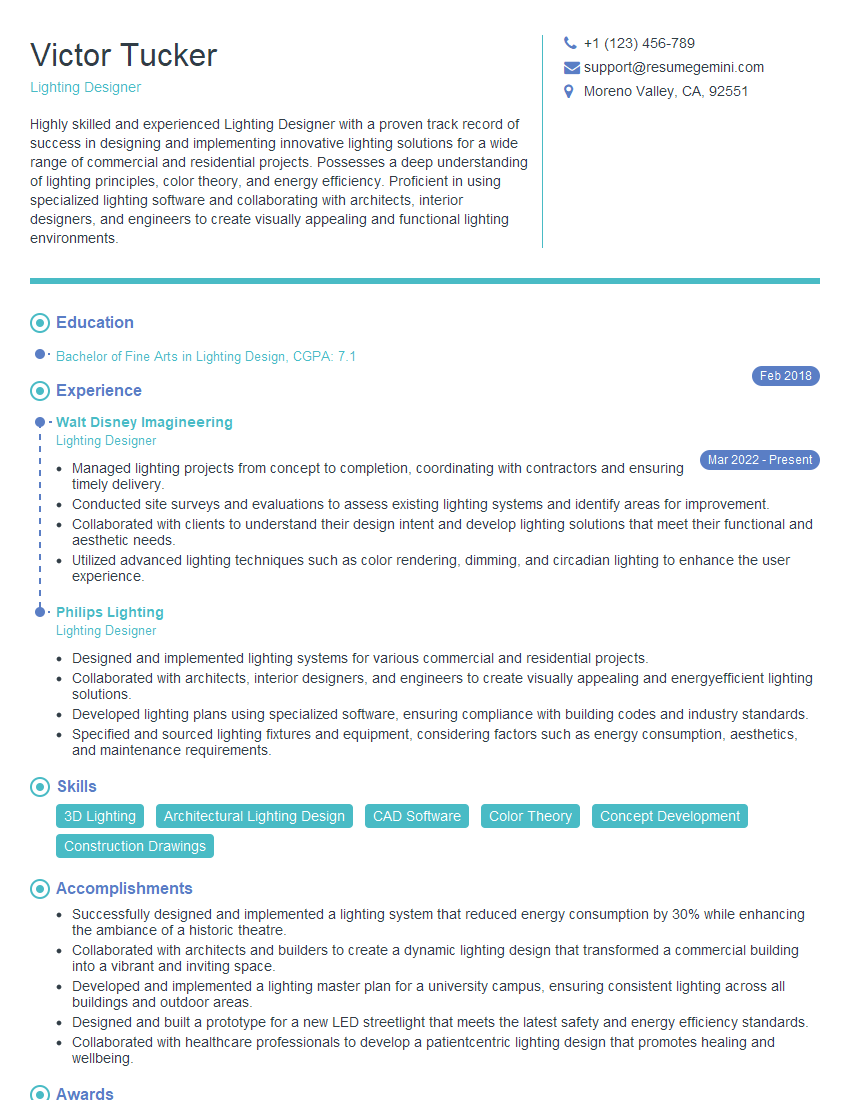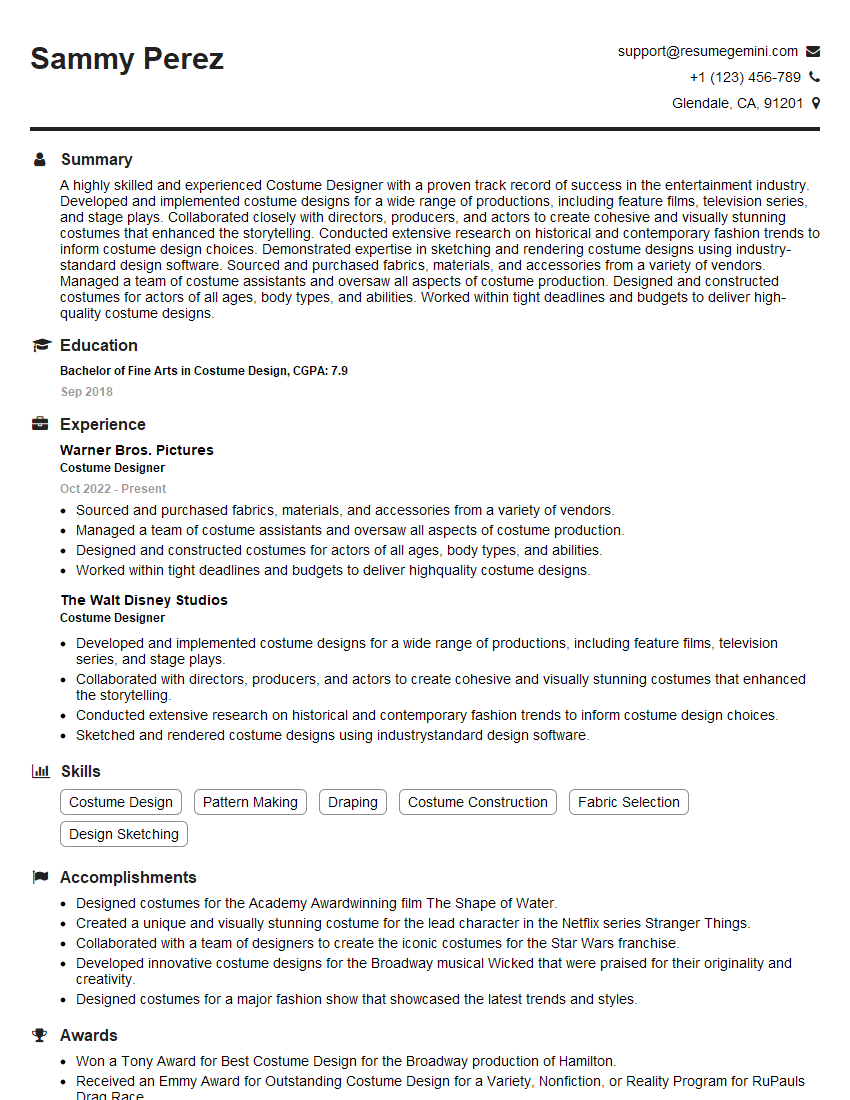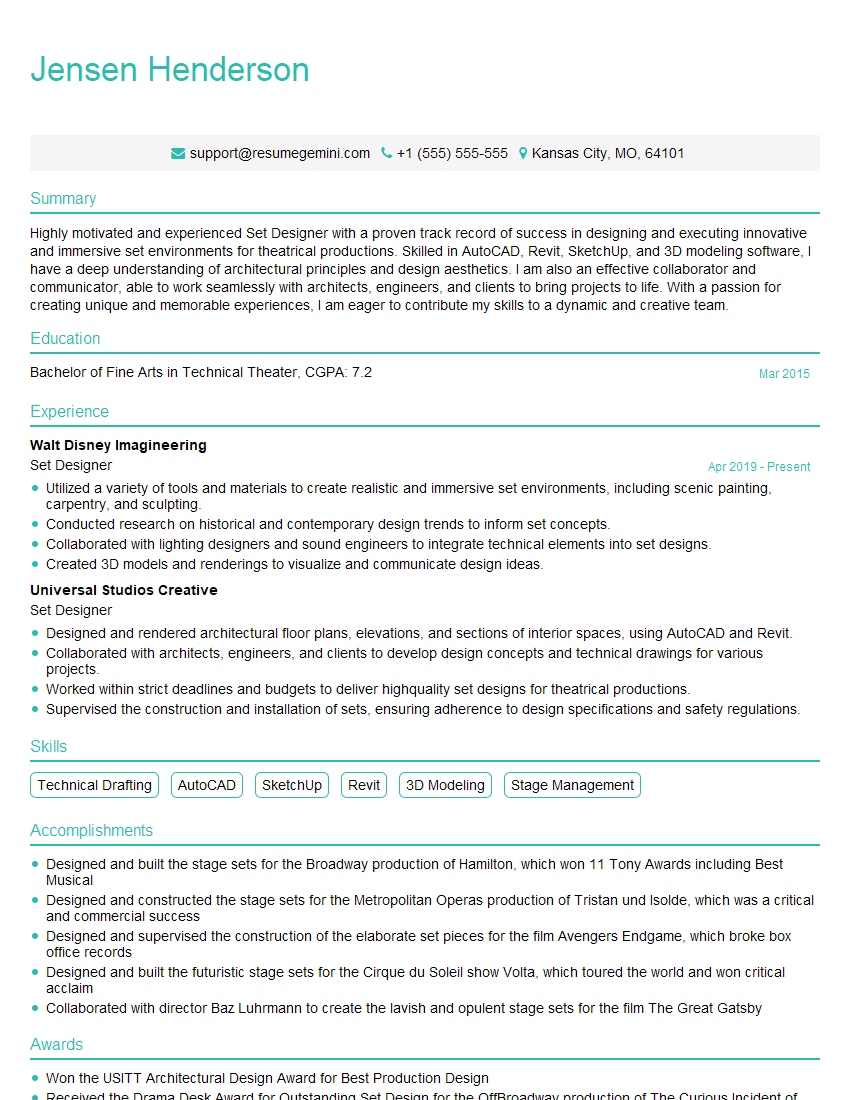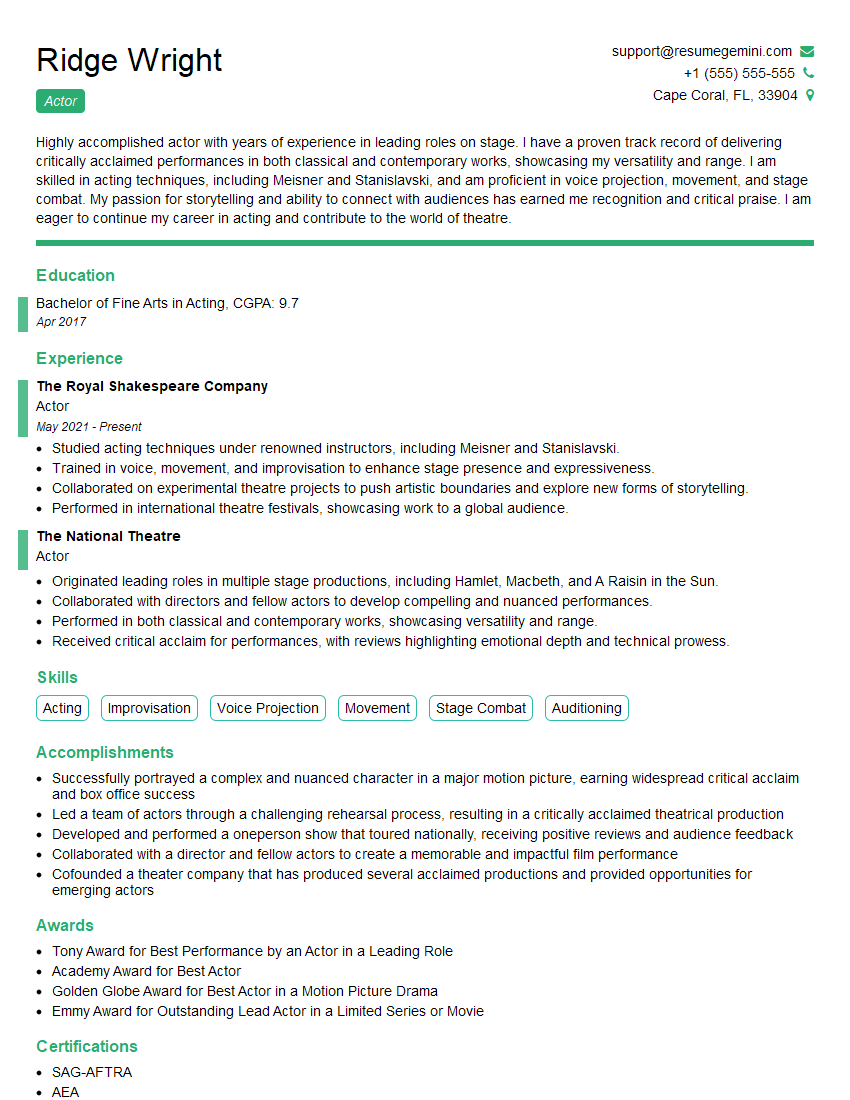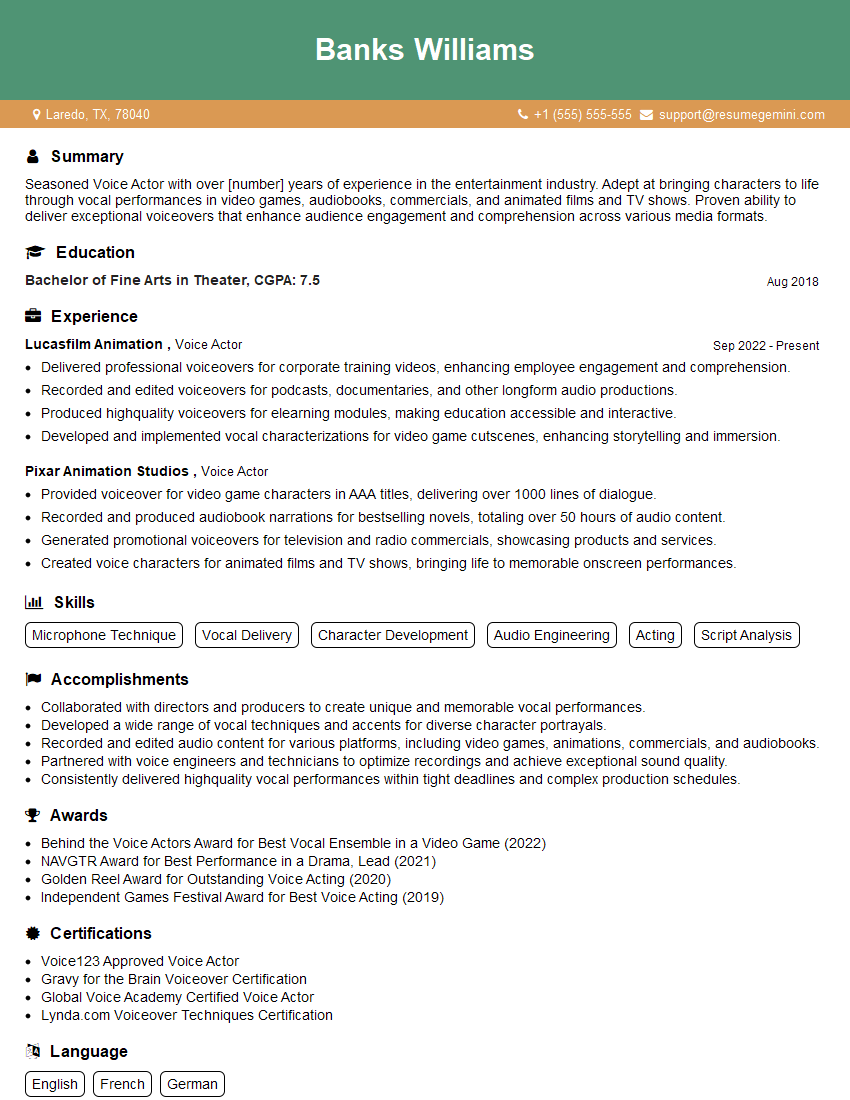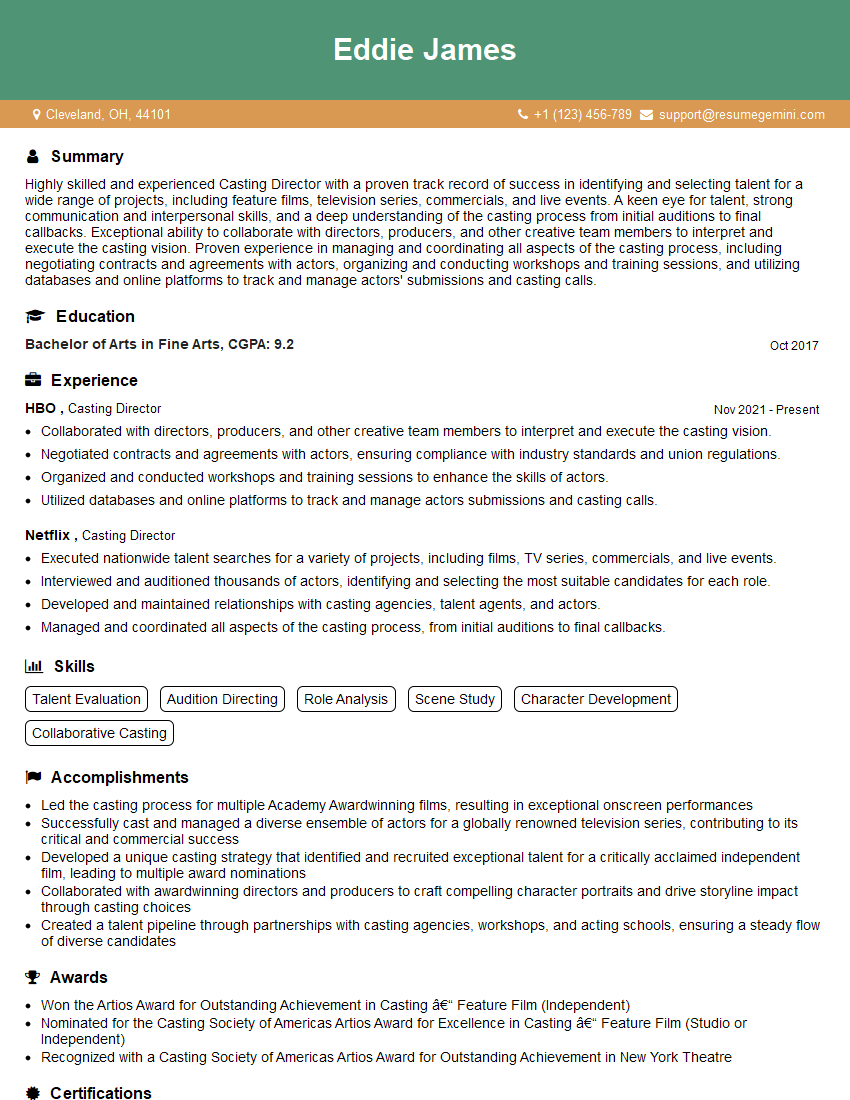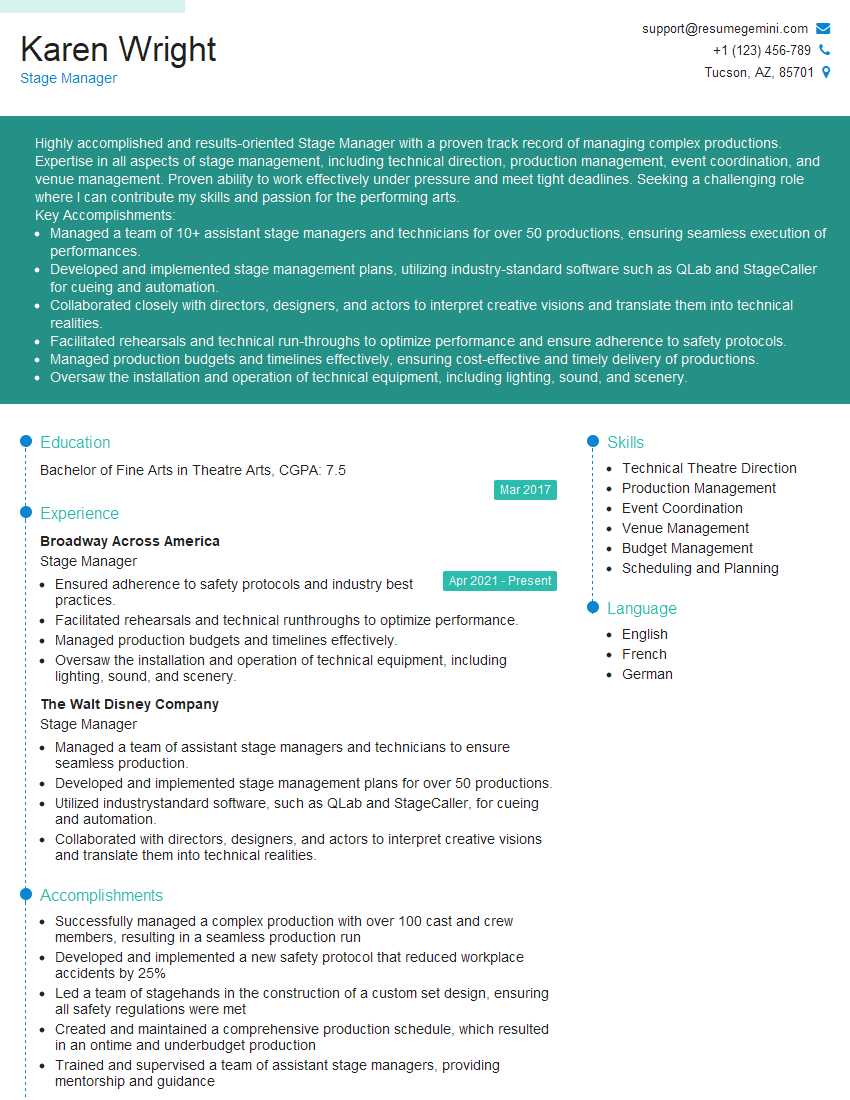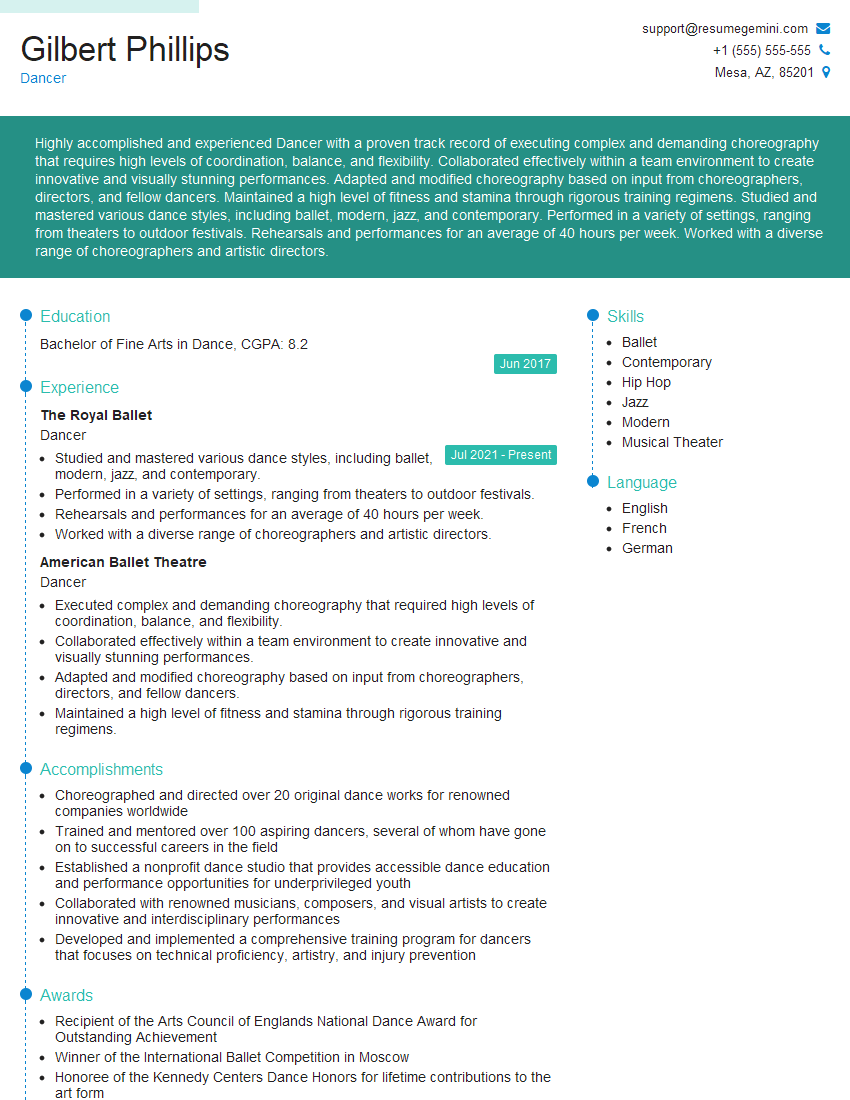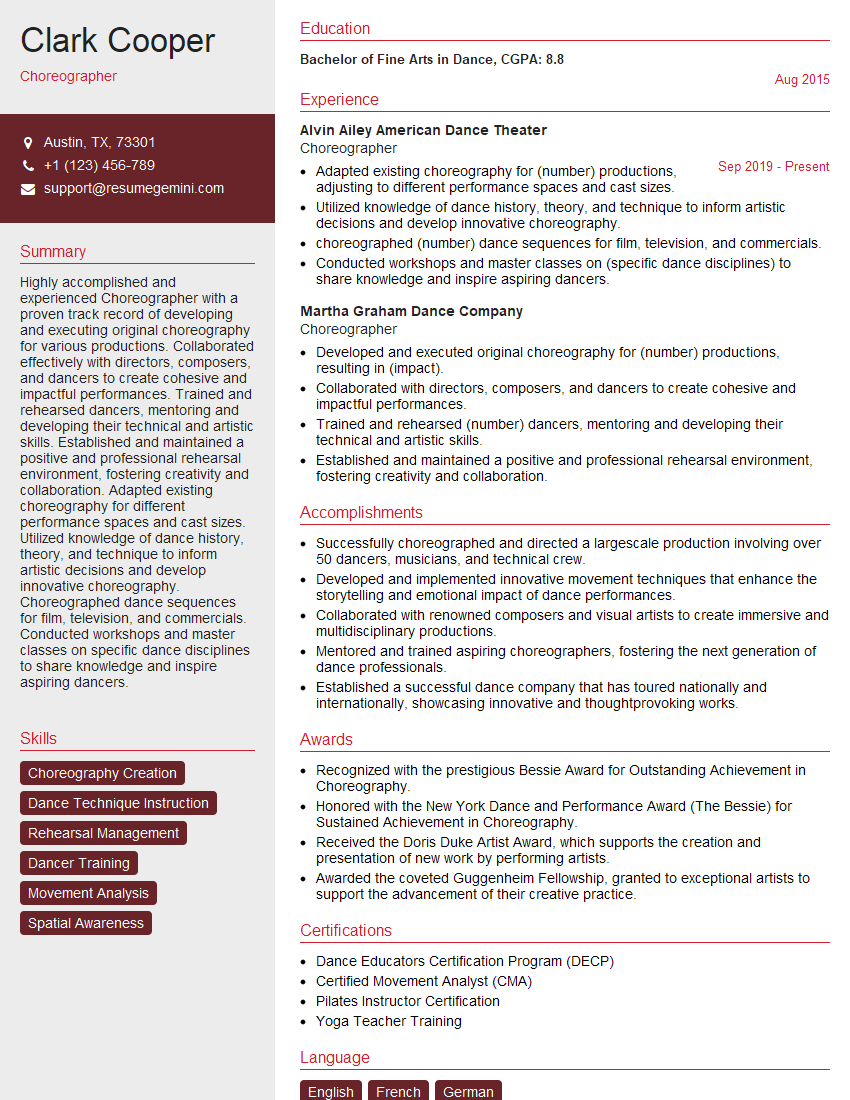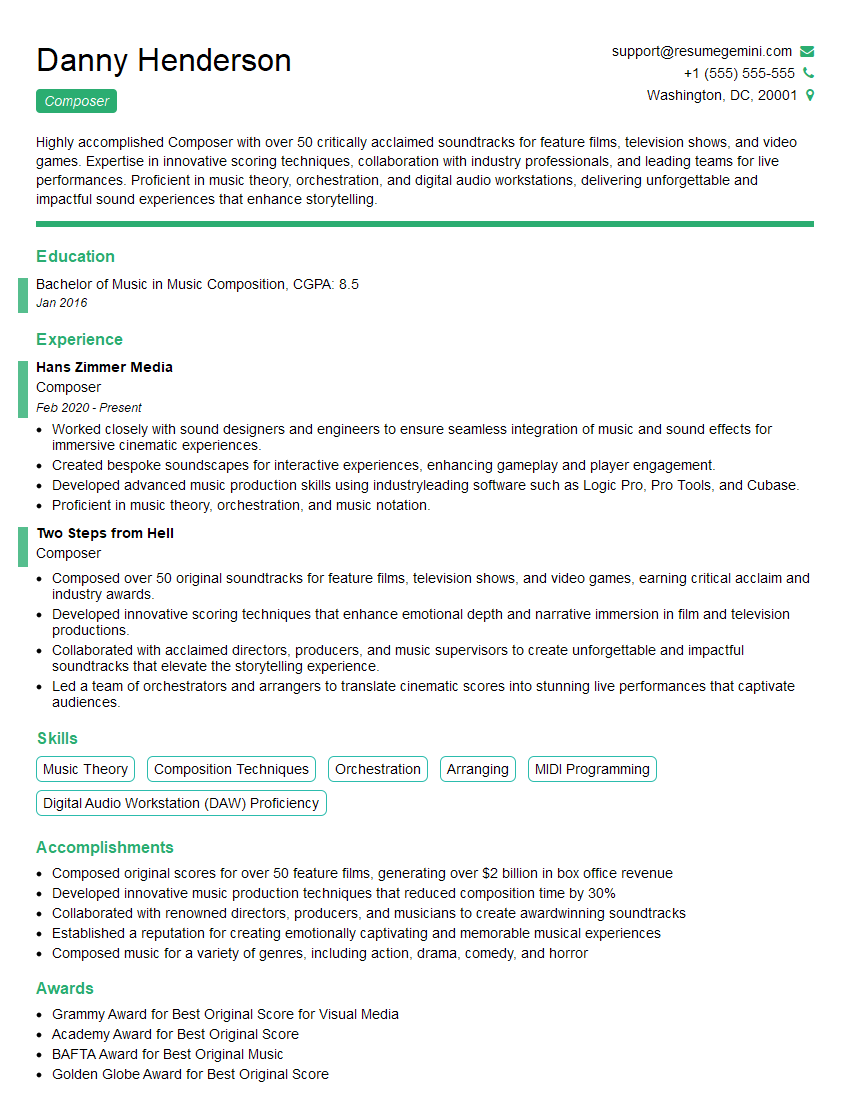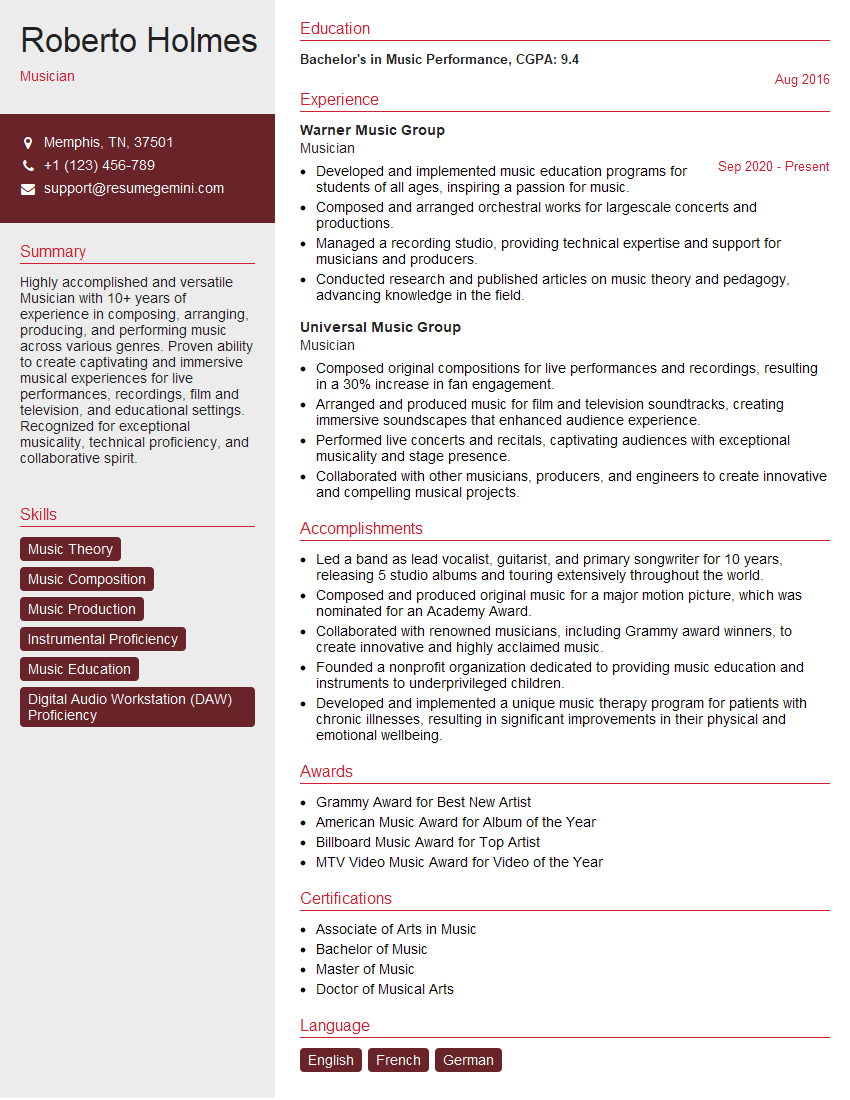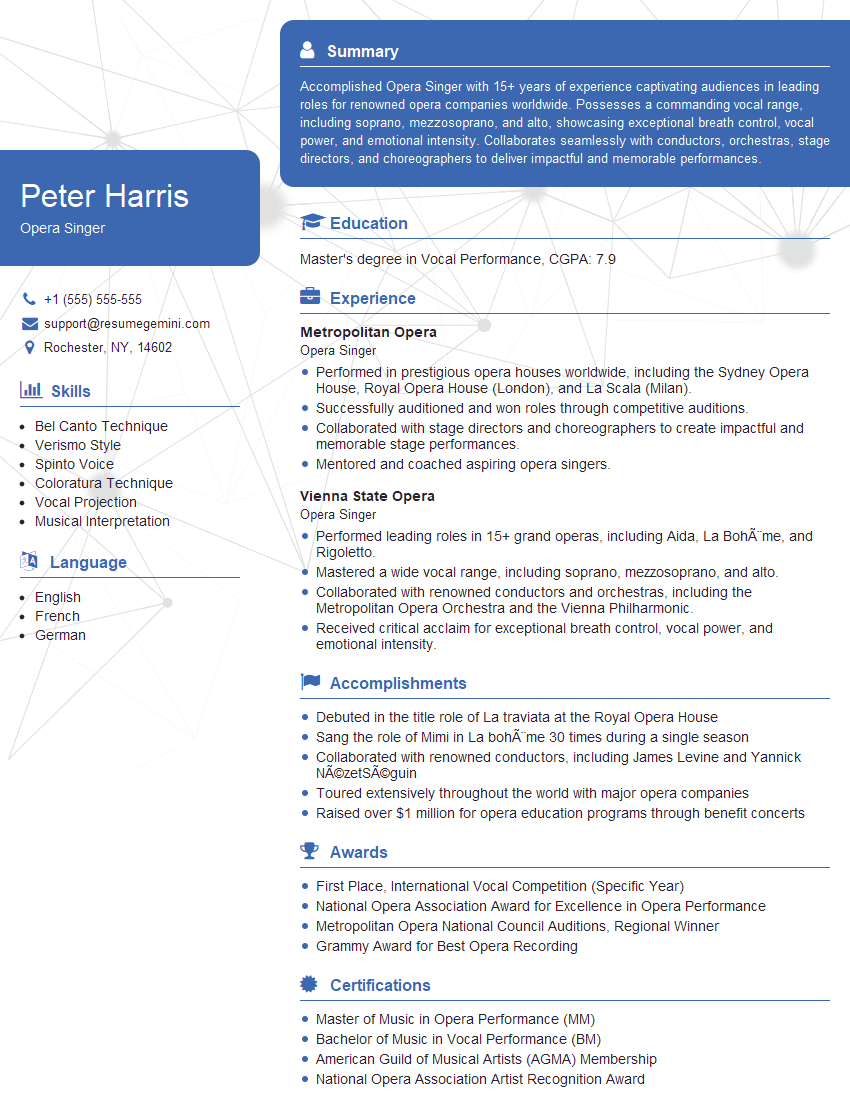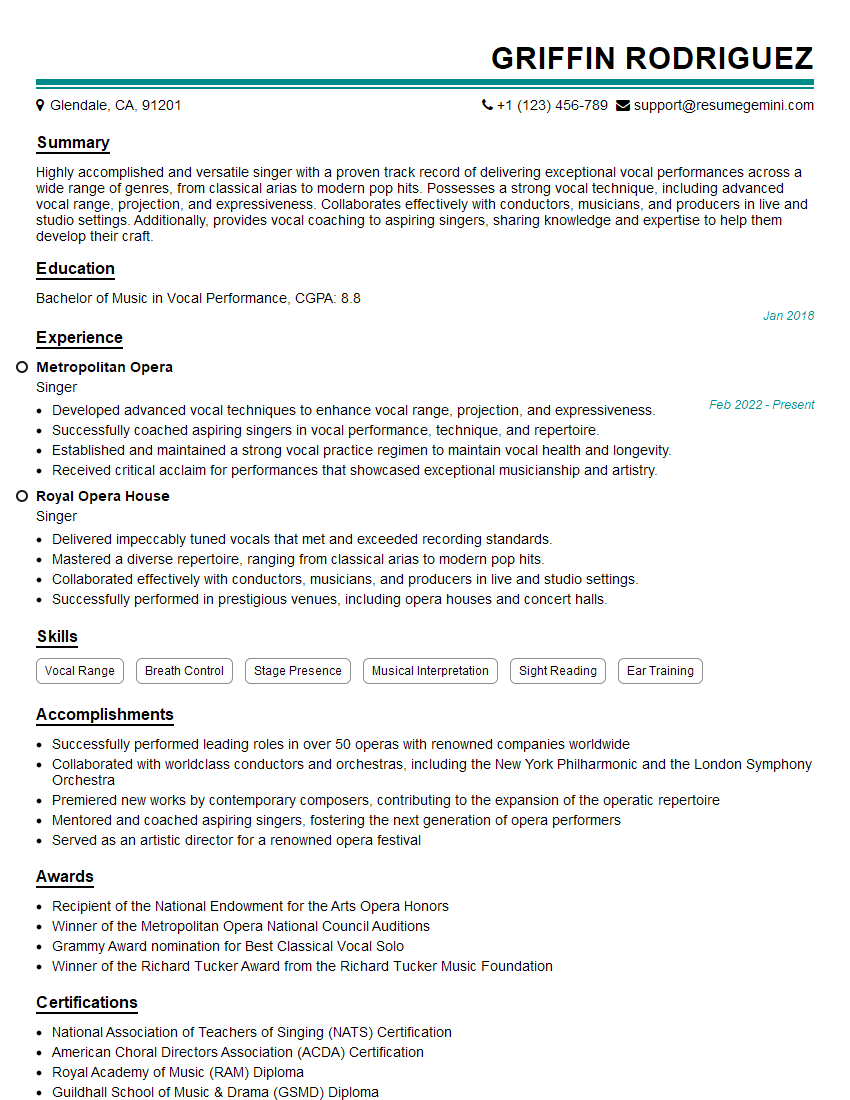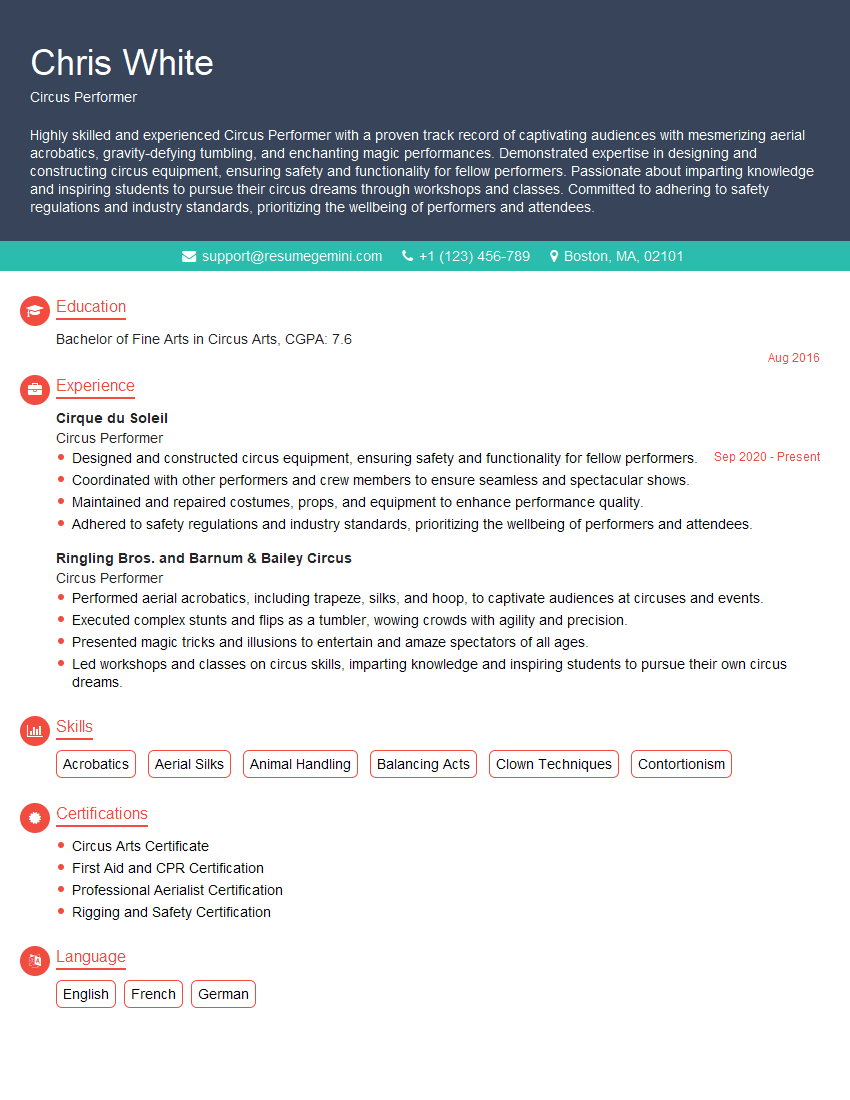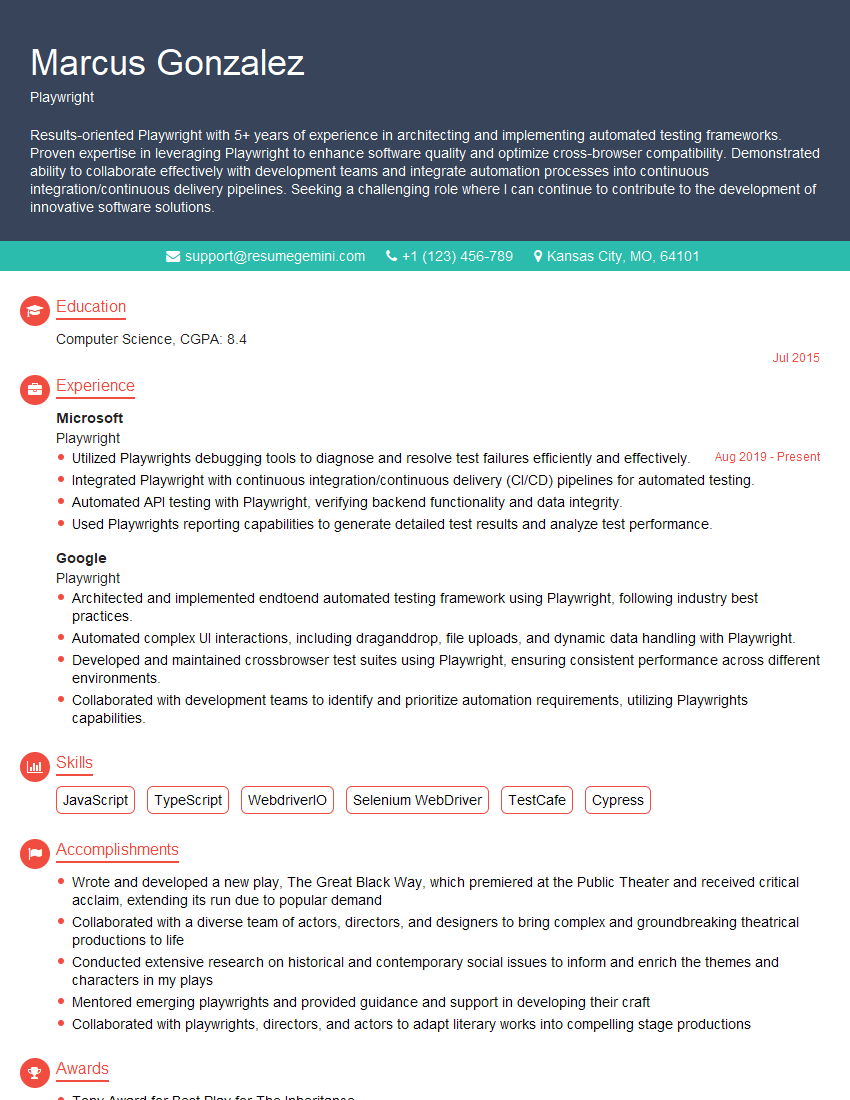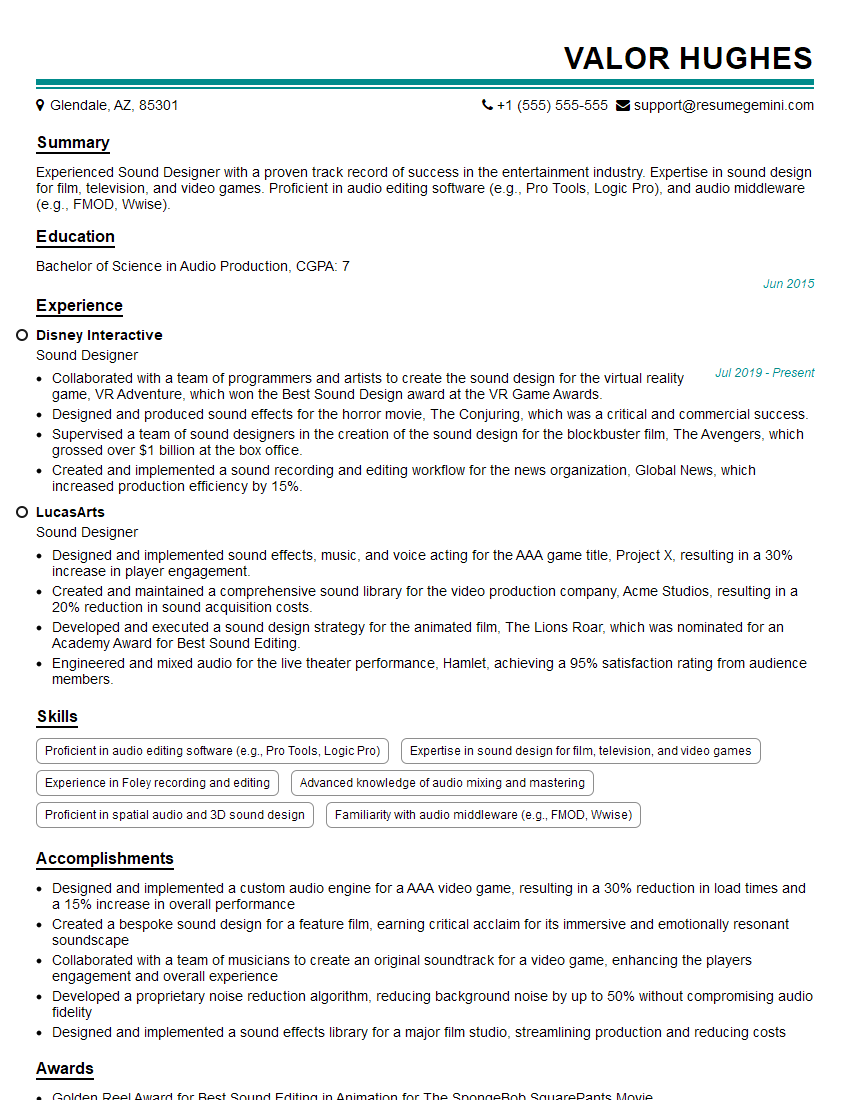Preparation is the key to success in any interview. In this post, we’ll explore crucial Background in performing arts interview questions and equip you with strategies to craft impactful answers. Whether you’re a beginner or a pro, these tips will elevate your preparation.
Questions Asked in Background in performing arts Interview
Q 1. Describe your experience with stage combat techniques.
Stage combat is a highly specialized skill demanding precision, timing, and safety. My training encompasses various styles, including British Academy of Dramatic Combat (BADC) techniques, which emphasize realism while prioritizing safety. I’m proficient in several weapons (e.g., sword, rapier, knife, staff) and unarmed combat. My experience includes choreographing and performing fights for both stage and screen, ensuring each movement is believable and safe for all involved. I prioritize safety protocols meticulously – spotters are essential, and I always conduct thorough rehearsals before a live performance to minimize risk of injury. For example, in a recent production of Hamlet, I choreographed a duel scene that involved complex movements with rapiers and involved close collaboration with the fight director and fellow actors to ensure not only the realism of the fight, but the safety of all participants. The careful choreography and execution received positive feedback for both its authenticity and the actors’ apparent ease and safety throughout.
Q 2. Explain your process for memorizing lines and choreography.
Memorizing lines and choreography is a multifaceted process requiring dedication and strategic approaches. For lines, I begin by understanding the context and emotional arc of the character. I use a combination of techniques such as reading aloud repeatedly, breaking down scenes into smaller, manageable chunks, and incorporating mnemonic devices to help reinforce memory. I also find that working with other actors in rehearsal is exceptionally helpful— line readings, both individually and as a group, can enhance recall.
Choreography requires a different approach. I start by focusing on the physicality of each movement, understanding its purpose within the overall narrative. I often record myself practicing, reviewing the footage to identify areas requiring improvement in precision and flow. Repetition, combined with breaking down the sequence into smaller sections, is crucial. I also utilize muscle memory by actively performing the choreography until it becomes second nature. Regular rehearsals are fundamental for ensuring both the accuracy and the expression of the dance/movement sequence. Ultimately, understanding the ‘why’ behind each movement – whether it be emotion, character development, or a movement within a broader artistic concept – is as important as the ‘how’.
Q 3. How do you handle constructive criticism from a director?
Constructive criticism is invaluable for growth. I approach it as an opportunity to learn and improve my performance. I listen actively, clarifying any points I don’t fully understand. I then consider the director’s feedback, identifying areas where I can refine my portrayal or technique. My response is collaborative rather than defensive. For example, if a director suggests a change in my character’s emotional arc, I’ll explore different approaches, discuss the reasoning behind the suggestion, and potentially suggest alternatives, ensuring a mutual understanding and improvement within a creative and respectful environment. I view feedback as a tool for refining and enhancing my performance, striving for continuous improvement.
Q 4. What is your preferred method for character development?
Character development is a deeply personal process that goes beyond superficial interpretation. My preferred method involves a multi-faceted approach. First, I thoroughly analyze the script, examining the character’s dialogue, actions, and relationships with other characters to understand their motivations, background, and goals. I then conduct extensive research, exploring the historical period, social context, and any relevant cultural aspects that inform the character. This research often extends beyond the provided script material. In addition to this research-based approach, I also use sensory exploration to embody the character – considering their physicality, posture, and voice – drawing inspiration from observing real people or from images, which helps bring the character to life. Finally, I work through improvisation exercises to further develop the character’s spontaneous reactions and behavior in different situations, allowing for greater depth and authenticity in my portrayal.
Q 5. Describe your experience working with different types of lighting setups.
My experience encompasses various lighting setups, from simple stage lighting to complex designs utilizing specialized effects. I understand how different lighting styles can significantly impact a performance, shaping mood, highlighting specific actions, and directing audience attention. I’m comfortable working with spotlights, followspots, cyc lighting, and other techniques. For example, I’ve worked with productions utilizing LED lighting, which allowed for dynamic and rapid color changes, adding a layer of visual spectacle, while other productions used more traditional lighting styles to create different moods. Adaptability is key; I readily adjust my performance to complement the lighting scheme, ensuring that my actions and expressions remain visible and effectively communicate my character’s emotions and the story’s essence.
Q 6. How do you adapt your performance to different audiences?
Adapting to different audiences requires sensitivity and awareness. I observe the audience’s energy and response during the performance. If an audience seems more reserved, I might adjust my performance to be slightly more subtle and understated. Conversely, an enthusiastic and responsive audience might warrant a more energetic and engaging presentation. However, the core of my performance remains consistent; I do not alter the fundamental elements of the character or the story. The adaptation focuses on the delivery, the emphasis of certain lines or actions, adjusting energy levels and pacing, in a way that maximizes connection without compromising the integrity of the work. It is a matter of subtle calibration to create a resonance with the audience without fundamentally changing the underlying performance.
Q 7. Explain your understanding of theatrical blocking and its importance.
Theatrical blocking refers to the precise arrangement and movement of actors on stage. It is critical for storytelling, establishing character relationships, and creating visual interest. Effective blocking enhances the narrative flow, supports the emotional impact of scenes, and optimizes audience viewing. Poor blocking can lead to confusion, hindering the audience’s understanding of the action. My understanding stems from years of experience both performing in and assisting with blocking for numerous productions. I understand how to use space effectively to showcase character relationships, to build tension, and to help the audience follow the action seamlessly. Careful blocking considerations include creating clear sightlines, minimizing distractions, maximizing stage use, and creating dynamism through movement. It’s a collaborative process involving the director and the actors, where we work together to refine the staging and movement to best serve the script and the production’s overall vision.
Q 8. How do you collaborate effectively with other performers and crew members?
Effective collaboration in the performing arts hinges on clear communication, mutual respect, and a shared understanding of the artistic goals. It’s about being a team player, not a soloist. I approach collaboration by actively listening to my fellow performers and crew members, offering constructive feedback, and being flexible and adaptable to changing circumstances.
For example, during a recent production of A Midsummer Night’s Dream, I worked closely with the lighting designer to ensure my character’s emotional transitions were subtly yet effectively highlighted. This involved suggesting specific lighting cues at key moments, and being open to their expertise in creating the overall visual impact. We also collaborated with the sound crew to fine-tune the sound effects during the more frantic scenes, carefully coordinating our actions to avoid any mishaps.
Another key element is proactive problem-solving. If I encounter a conflict, I address it directly and respectfully, focusing on finding solutions that benefit the entire production. This approach is crucial for maintaining positive morale and fostering a cooperative environment.
Q 9. Describe a time you had to overcome a technical difficulty during a performance.
During a performance of West Side Story, the microphone for my character, Maria, suddenly cut out mid-song. My initial reaction was a jolt of panic, but I immediately switched to problem-solving mode. My years of training kicked in, and I instinctively utilized projection techniques to amplify my voice, reaching the audience without relying on the microphone. Simultaneously, I subtly signaled to the stage manager to address the technical issue.
The experience taught me the importance of adaptability and quick thinking in live performance. While I was initially upset, the audience hardly noticed the interruption, proving that skillful improvisation and professionalism can overcome many challenges. Post-show, I discussed the issue with the sound technician to prevent similar problems in future performances. This collaboration strengthened our communication, ensuring better technical preparedness for all future performances.
Q 10. How do you maintain vocal health and stamina?
Maintaining vocal health and stamina requires a holistic approach that encompasses several key strategies. This includes daily vocal exercises to warm up and cool down the vocal cords, avoiding excessive strain, and consistently hydrating.
- Hydration: Drinking plenty of water throughout the day is essential to keep the vocal cords lubricated and prevent dryness.
- Vocal Warm-ups: These exercises prepare the vocal cords for performance by improving flexibility and range. I typically use hums, scales, and lip trills.
- Vocal Rest: Sufficient rest is crucial. This includes avoiding whispering (which can be more damaging than speaking), and giving my voice ample time to recover after strenuous performances.
- Healthy Lifestyle: A balanced diet, regular exercise, and sufficient sleep significantly contribute to overall health and vocal well-being. Avoiding smoking and excessive alcohol consumption is also critical.
- Professional Guidance: Regular check-ups with a vocal coach or ENT specialist can identify and address potential issues early on.
Think of your voice like a finely tuned instrument – it needs consistent care and maintenance to perform at its best.
Q 11. Explain your understanding of different vocal techniques (e.g., belting, breath support).
Vocal techniques are fundamental to achieving optimal vocal production and expression.
- Belting: Belting is a powerful vocal technique that involves projecting the voice using a combination of chest and head resonance. It requires precise control to avoid damaging the vocal cords, often involving specific placement of the voice and management of breath support. It’s not about yelling, but rather a controlled, resonant sound.
- Breath Support: This refers to the efficient use of the diaphragm and abdominal muscles to provide a steady stream of air to support the voice. Proper breath support is crucial for achieving vocal stamina and control, preventing strain and breathiness. It’s like having a reliable foundation for your vocal performance.
- Resonance: This is the amplification of the sound waves within the vocal tract, shaping the timbre (the quality of the sound). Different resonant spaces in the mouth, nose and chest cavity can be selectively utilized, resulting in a rich and varied sound.
- Vocal Registers: These are different areas of the voice, often described as chest voice, head voice, and mixed voice. Mastering transitions between registers is essential for a smooth and seamless vocal delivery. It’s like having access to a wider palette of colours to paint your vocal performance.
Understanding and effectively utilizing these techniques allow performers to craft expressive and nuanced vocal performances across a wide range of genres and styles. It’s crucial to have a good balance and work to achieve a technique appropriate to one’s voice type and goals, as improper technique can lead to vocal damage.
Q 12. What are your strengths and weaknesses as a performer?
My greatest strength as a performer lies in my versatility and adaptability. I’m comfortable tackling a wide range of roles, from dramatic to comedic, and I’m adept at quickly learning and embodying new characters. Furthermore, I’m a dedicated team player who prioritizes collaboration. My attention to detail ensures that I am always well-prepared.
However, I also recognize that a potential weakness is my tendency to be a perfectionist, sometimes leading to excessive self-criticism. I am actively working on mitigating this by focusing on self-compassion and celebrating small victories. Through consistent self-reflection and seeking feedback, I am striving to develop a more balanced approach and create a better relationship with myself within my performances.
Q 13. Describe your experience with improvisation.
Improvisation is a crucial skill for any performer, requiring quick thinking, adaptability, and a willingness to embrace spontaneity. My experience with improvisation spans several years, from participating in improv workshops to incorporating improvisational elements into various theatrical productions.
I’ve found that successful improvisation relies on active listening, building upon the ideas of others, and having a strong understanding of comedic timing and character development. For example, in a recent workshop, we had to create a scene from scratch based on a single suggested word: “umbrella”. This necessitated instant character creation, conflict generation and a strong understanding of our audience. It pushes you to think outside the box, fostering creativity and allowing us to craft something truly unique. This type of adaptability translates well to unexpected problems that might arise during a live performance, enabling quick thinking and problem-solving.
Q 14. How do you manage stage fright or performance anxiety?
Stage fright and performance anxiety are common experiences among performers. My approach involves a combination of mental and physical techniques.
- Preparation: Thorough preparation significantly reduces anxiety. Knowing the material inside and out allows me to focus on performance rather than memorization.
- Mindfulness and Meditation: Practicing mindfulness and meditation techniques helps to calm my nerves and center myself before a performance. Deep breathing exercises also help regulate my heart rate and reduce tension.
- Positive Self-Talk: I employ positive self-talk to counter negative thoughts. I remind myself of my past successes and focus on the joy of performing.
- Visualization: Visualizing a successful performance helps to build confidence and reduce feelings of apprehension.
- Physical Warm-ups: Engage in physical exercises to release tension and get the body ready. This can involve light stretching, dancing or even just brisk walking.
Over time, I’ve learned that stage fright is a natural response, and managing it is a matter of developing effective coping strategies. The key is to channel nervous energy into positive action and focus on connecting with my fellow performers and, most importantly, the audience.
Q 15. Explain your process for learning and executing new choreography.
Learning and executing new choreography is a multi-stage process that blends analytical thinking with physical practice. It begins with careful observation and understanding of the choreographer’s intent. I start by watching the piece multiple times, noting not just the steps but the nuances of movement, the phrasing, the emotional arc, and the overall style.
Next, I break down the choreography into smaller, manageable sections. I meticulously learn each section, focusing on precision and muscle memory. This often involves practicing in front of a mirror to refine technique and identify areas needing improvement. I utilize different mnemonic devices – like associating steps with musical phrases or creating mental images – to aid memorization. Rehearsing with others is invaluable; it allows me to understand the spatial relationships between dancers and synchronize movements effectively. Finally, I refine the performance by incorporating personal interpretation while staying true to the choreographer’s vision. For instance, when learning a contemporary piece, I might emphasize certain emotional cues through subtle adjustments in my facial expressions or body language, adding my own artistic flavor.
For example, when learning a complex ballet sequence, I’d initially focus on mastering each individual step (e.g., fouetté, arabesque) before integrating them seamlessly into the full sequence. I’d then work on transitions, ensuring smooth and elegant movements between different poses.
Career Expert Tips:
- Ace those interviews! Prepare effectively by reviewing the Top 50 Most Common Interview Questions on ResumeGemini.
- Navigate your job search with confidence! Explore a wide range of Career Tips on ResumeGemini. Learn about common challenges and recommendations to overcome them.
- Craft the perfect resume! Master the Art of Resume Writing with ResumeGemini’s guide. Showcase your unique qualifications and achievements effectively.
- Don’t miss out on holiday savings! Build your dream resume with ResumeGemini’s ATS optimized templates.
Q 16. Describe your understanding of different dance techniques (e.g., ballet, jazz, modern).
My understanding of various dance techniques is extensive, encompassing the foundational principles and stylistic nuances of several disciplines. Ballet forms the bedrock of many other dance forms, emphasizing precise technique, turnout, and graceful, controlled movements. I’m proficient in ballet’s various forms, including classical and neoclassical styles. Jazz dance, on the other hand, is characterized by its rhythmic energy, syncopation, and improvisational elements. Its vocabulary includes isolations, jumps, and intricate footwork. Modern dance, known for its expressive freedom, prioritizes emotional communication through movement. It often involves floor work, unique body placements, and exploration of unconventional body dynamics.
The differences are clear: ballet focuses on precision and classical elegance, jazz emphasizes rhythm and style, and modern prioritizes emotional expression and artistic freedom. Each style requires specific training and an understanding of its underlying aesthetic principles. My experience working with each style helps me appreciate their distinct characteristics, and blend their elements creatively in diverse performance settings.
Q 17. How do you utilize music theory in your performance or composition?
Music theory is fundamental to my performance and composition. A solid understanding of rhythm, melody, harmony, and form informs every aspect of my work. In performance, I use my knowledge of musical structure to anticipate changes in tempo, dynamics, and rhythmic patterns, enabling me to express the music’s emotion and subtleties through movement. This means I can match shifts in musical intensity with corresponding shifts in my energy levels and movement quality.
In composition, music theory provides a framework for creating compelling choreography. I construct sequences according to musical phrasing and structure, ensuring that movement complements and emphasizes the music’s emotional trajectory. For example, a crescendo in the music might be mirrored by increasingly energetic and powerful movements. A change in key can signal a shift in character or mood, influencing both the style and the vocabulary of the choreography.
Q 18. Describe your experience with conducting or arranging music.
My experience with conducting and arranging music is primarily focused on the context of dance. While I haven’t conducted a full symphony orchestra, I have experience leading dance ensembles, often incorporating musical direction alongside choreography. This involves a deep understanding of the music’s nuances, adjusting the pacing and phrasing to complement the dance movements. In terms of arranging, I often work on adapting existing music for dance, selecting and arranging sections of scores to fit the choreography’s emotional progression and structure. I carefully analyze the musical score, identifying key moments to emphasize through specific choreography. This often requires making cuts, transitions and adding or subtracting sections to effectively support the dance.
For instance, while working on a piece set to a classical concerto, I might focus on specific sections – perhaps a soaring melody in the second movement – to create dramatic climaxes in the choreography.
Q 19. What software or tools are you proficient in for music production or composition?
My proficiency in music production and composition software includes Sibelius for notation, and Ableton Live for audio editing and mixing. Sibelius allows me to notate musical scores with precision and clarity, creating a visual representation of the music that is crucial for choreography. Ableton Live allows me to create and manipulate audio, add sound effects, and refine musical textures, adding another layer of complexity to my choreography and productions. Proficiency in these tools helps me seamlessly integrate music and movement in my work.
Q 20. How do you approach designing costumes for a specific period or style?
Designing costumes for a specific period or style requires extensive research and attention to detail. I begin by thoroughly researching the historical context of the chosen period or style, studying visual resources like paintings, photographs, and film clips. This research helps me understand the prevailing fashion trends, silhouette, fabrics, and embellishments relevant to the time. I consider factors like social class, geographical location, and the specific character being portrayed, adapting the costume design accordingly.
For example, designing costumes for a 1920s flapper dance would involve incorporating elements such as dropped waists, beaded fringes, and loose, flowing fabrics. Researching specific photographs and paintings from the era would ensure authenticity and accuracy. I create detailed sketches and mood boards to visualize the design before moving into fabric selection and construction. The goal is to create costumes that are not only visually appealing but also historically accurate and appropriate for the movement and setting of the dance.
Q 21. Describe your experience with different sewing techniques.
My sewing skills encompass a range of techniques crucial for costume construction. I’m proficient in basic techniques like hand-sewing, machine sewing, and pattern making. I can execute various seams, such as French seams, flat-fell seams, and bound seams, selecting the most appropriate technique based on the fabric and design. I’m comfortable working with different fabrics, from delicate silks to sturdy cottons, and I know how to adapt my techniques for each fabric’s specific properties. Embellishment techniques, including beading, embroidery, and appliqué, are also part of my skillset. This comprehensive range of skills enables me to create costumes that are both aesthetically pleasing and durable.
For example, when constructing a historically accurate costume, I might employ hand-sewing techniques for intricate detailing and machine sewing for larger sections of fabric. Knowing when and how to utilize various seams is essential for ensuring a garment’s strength and longevity.
Q 22. Explain your understanding of theatrical makeup techniques.
Theatrical makeup is a transformative art form, going beyond mere cosmetics to create believable characters and enhance storytelling. It encompasses a wide range of techniques, each serving a specific purpose. For example, aging makeup uses techniques like stippling and layering to simulate wrinkles, age spots, and sagging skin. Character makeup might involve prosthetics, specialized paints, and sculpting to create fantastical or exaggerated features. Corrective makeup aims to subtly balance facial features, creating a more harmonious and even appearance for the actor. Fantasy makeup allows for extreme creativity, often using vibrant colors, unusual textures, and special effects to realize fantastical creatures or otherworldly beings.
My expertise extends to the practical application of all these techniques. I’m proficient in applying and blending various foundations, powders, and pigments to achieve a natural or highly stylized look. I understand the importance of proper skin preparation, color theory, and the use of tools such as brushes, sponges, and airbrushes to achieve precise and seamless results. I’ve worked extensively with prosthetics, including applying, blending, and removing them without causing discomfort to the actor. For instance, in a recent production of ‘Macbeth,’ I successfully aged the lead actor by over 20 years using a combination of stippling, highlighting, shadowing, and strategically placed wrinkles.
Q 23. How do you manage time effectively during a production’s timeline?
Effective time management in a theatrical production is crucial for success. It requires a proactive and organized approach. My strategy involves breaking down the entire production timeline into smaller, manageable tasks, assigning deadlines to each, and consistently monitoring progress. I utilize project management tools, such as Gantt charts or Trello boards, to visualize the workflow and identify potential bottlenecks early on. I prioritize tasks based on urgency and importance, ensuring that critical elements, such as costume creation or set construction, are completed well in advance.
Collaboration is key. I maintain open communication with all team members, keeping them informed of deadlines and progress, and actively seeking their input to ensure everyone stays aligned. Regular check-ins and meetings help to identify and address potential issues promptly. For instance, during a recent musical, I successfully implemented a color-coded timeline that visually represented each task’s progress, allowing for immediate identification of delays and facilitating corrective action.
Q 24. Describe your experience with budget management in a theatrical production.
Budget management is a vital skill in theatrical productions. My experience involves meticulous planning and tracking of expenses from the initial budgeting phase through to the final reconciliation. I start by collaborating with the production team to develop a detailed budget that accounts for all anticipated costs, including materials, labor, rentals, and marketing. I then meticulously track expenses against the budget throughout the production, using spreadsheets or dedicated budgeting software. Regular review meetings are essential to ensure we remain on track and make necessary adjustments.
One example was a low-budget Shakespeare production where I had to creatively source materials and explore cost-effective solutions without compromising quality. I negotiated favorable rental rates for equipment, sourced props from thrift stores, and even rallied volunteers to assist with tasks. Through meticulous planning and strategic cost-cutting, we successfully delivered a high-quality production within the allocated budget, demonstrating resourcefulness and financial responsibility.
Q 25. How do you handle conflict resolution within a production team?
Conflict resolution is an inevitable aspect of collaborative projects like theatrical productions. My approach prioritizes open communication and respectful dialogue. I encourage team members to express their concerns openly, creating a safe space where disagreements can be addressed without judgment. I actively listen to all perspectives, identify the root cause of the conflict, and work collaboratively to find mutually acceptable solutions. Compromise and empathy are crucial.
In one instance, a disagreement arose between the costume designer and the lighting designer regarding the visibility of certain costume details under specific lighting conditions. Instead of taking sides, I facilitated a collaborative problem-solving session, involving both parties in finding a creative solution that satisfied both aesthetic and technical requirements. This resulted in a strengthened working relationship and ultimately, a more visually compelling production.
Q 26. What are your career goals within the performing arts industry?
My career goals center on achieving creative leadership within the performing arts industry. I aspire to work as a Production Manager or Head of Makeup for a renowned theater company, where I can leverage my skills in budgeting, scheduling, and team management to deliver high-quality productions. I also envision expanding my expertise into special effects makeup, allowing me to contribute to a broader range of theatrical and potentially film projects.
Ultimately, I strive to contribute to the creation of impactful and memorable theatrical experiences, enriching the lives of both artists and audiences. This involves continuous professional development and a commitment to exploring innovative techniques and technologies within the field.
Q 27. Describe your experience with marketing and promotion of theatrical productions.
Marketing and promotion are critical for a theatrical production’s success. My experience involves developing and implementing comprehensive marketing strategies, targeting various audience segments. This includes creating compelling promotional materials – flyers, posters, website content – that effectively communicate the production’s unique value proposition. I leverage social media platforms to build anticipation and engagement, while also exploring partnerships with local media outlets to secure coverage and expand reach.
For a recent student production, I developed and executed a social media campaign that successfully increased ticket sales by 30% by employing targeted advertising and interactive content. This demonstrates my ability to use online tools to effectively market theatrical events to a modern audience.
Q 28. How do you stay current with trends and developments in the performing arts?
Staying current in the dynamic performing arts landscape requires continuous learning and engagement. I regularly attend industry conferences and workshops, such as those hosted by the Society of Stage Lighting and Sound, to stay abreast of the latest trends and techniques in stagecraft and production. I subscribe to industry publications and online resources, such as professional journals and online forums. I also actively network with other professionals in the field, attending industry events and engaging in online communities.
Furthermore, I actively seek opportunities to expand my skill set through independent study and experimentation with new technologies and techniques. This ensures I remain a versatile and adaptable professional capable of meeting the evolving needs of the industry.
Key Topics to Learn for Background in Performing Arts Interview
- Performance Techniques: Understanding various acting styles, vocal techniques, movement and dance styles, and their practical application in different performance contexts. Consider how your training informs your approach to character development and storytelling.
- Collaboration and Teamwork: Discuss experiences working collaboratively with directors, designers, fellow performers, and technical crews. Highlight your ability to contribute effectively within a team environment and adapt to diverse working styles. Emphasize problem-solving skills used to overcome challenges during rehearsals or performances.
- Character Analysis and Interpretation: Explore your approach to understanding and portraying characters. Detail your methods for researching roles, developing believable characterizations, and conveying emotional depth. Be prepared to discuss specific examples from your performance repertoire.
- Stagecraft and Production: Demonstrate your knowledge of technical aspects such as set design, lighting, sound, and costuming. Discuss how these elements contribute to the overall performance and your understanding of the collaborative process. Consider your role in ensuring a cohesive and effective production.
- Professionalism and Work Ethic: Highlight your commitment to punctuality, responsibility, and adaptability within a demanding performance environment. Discuss your ability to handle pressure, meet deadlines, and maintain a professional demeanor.
- Adaptability and Resilience: Discuss how you’ve overcome challenges or setbacks in your performance career. Showcasing your ability to adapt to changing circumstances and bounce back from difficulties demonstrates valuable resilience and problem-solving skills.
Next Steps
A strong background in performing arts equips you with invaluable transferable skills highly sought after in many industries – communication, teamwork, adaptability, creativity, and problem-solving. Mastering these skills and presenting them effectively is crucial for career growth. To maximize your job prospects, it’s essential to create an ATS-friendly resume that showcases your unique talents and experience. ResumeGemini is a trusted resource that can help you build a professional and impactful resume, significantly enhancing your chances of securing interviews. Examples of resumes tailored specifically to highlight a background in performing arts are available through ResumeGemini.
Explore more articles
Users Rating of Our Blogs
Share Your Experience
We value your feedback! Please rate our content and share your thoughts (optional).
What Readers Say About Our Blog
These apartments are so amazing, posting them online would break the algorithm.
https://bit.ly/Lovely2BedsApartmentHudsonYards
Reach out at [email protected] and let’s get started!
Take a look at this stunning 2-bedroom apartment perfectly situated NYC’s coveted Hudson Yards!
https://bit.ly/Lovely2BedsApartmentHudsonYards
Live Rent Free!
https://bit.ly/LiveRentFREE
Interesting Article, I liked the depth of knowledge you’ve shared.
Helpful, thanks for sharing.
Hi, I represent a social media marketing agency and liked your blog
Hi, I represent an SEO company that specialises in getting you AI citations and higher rankings on Google. I’d like to offer you a 100% free SEO audit for your website. Would you be interested?

